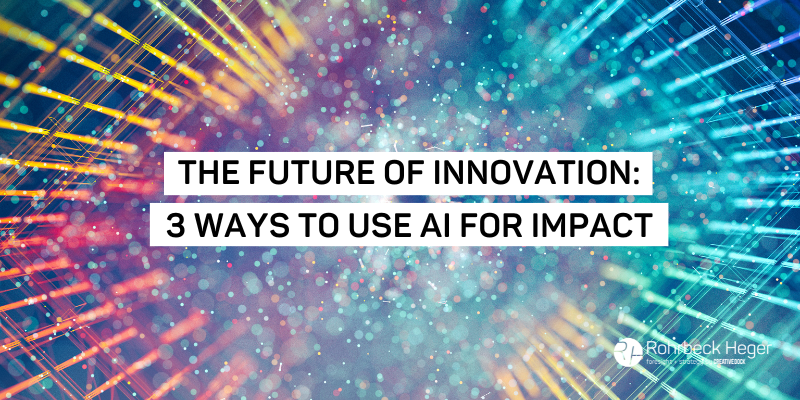
The Future of Innovation: 3 Ways to Use AI for Impact
Nowadays, only 8% of companies are using what is considered to be a revolutionary, but fundamental technology for the years to come, namely Artificial Intelligence (AI).
Despite its still cautious adoption, AI is considered to be a game changer for businesses, since it enables companies to, above all, save money, increase efficiency and productivity, reduce lead time and manage repetitive tasks. For example, AI could take over all those obnoxious tasks that no one in the company wants to do such as writing a real-time transcription of your online meeting.
For all these reasons, the interest towards the endorsement of AI tools from organizations is growing steadily.
Perhaps surprisingly, AI’s potential even makes a compelling case when it comes to what has so far been considered to be an exclusive human ability: innovation.
AI tools can indeed play a significant role in re-thinking innovation management and can already support in generating ideas. For these reasons alone, AI should be on every organization’s roadmap.
Here are three ways that AI is, and will continue to impact innovation:
- AI helps in identifying opportunity spaces
- AI can generate and select ideas
- Concept, development and launch phases can all be enhanced with AI
1. AI helps in identifying opportunity spaces
The most known AI ability is to process huge amounts of data in a short period of time, outperforming human skills easily.
By identifying relevant consumers’ pain points and needs, as well as trends and threats in different fields, AI tools can extract relevant insights and uncover opportunities.
A successful example of this application is to use AI to analyze a large amount of posts in discussion forums or on social media and extract new interesting customer needs; this task would cost us humans an infinite amount of time and energy.
Christian Mühlroth, CEO at Itonics, and a self-described AI and innovation enthusiast, describes how AI can replace the work of so-called “scouts” in anticipating future developments. By analyzing data sets, papers, external sources, or articles, AI tools can detect weak and strong signals for trends as well as emerging technologies and new products.
2. AI can generate and select ideas
Interestingly, AI can support organizations in generating novel ideas as well.
On the one hand, it overcomes human constraints in solving very complex and so far unsolved problems in fields such as chemistry and biology, where vast combinatorial spaces need to be inspected. For example, an AI called Alphafold was programmed to predict how proteins are folded, even down to an anatomic level.
On the other hand, AI comes in handy in performing also more “creative” tasks such as graphic design and music generation. Some artists, such as Holly Herndon, are already publishing AI-driven albums where a software generates sounds based on several hours of vocal samples. If you are curious, listen to this song for example.
Nonetheless, artists state that this process still needs significant human input to be successful.
Besides being (more?) creative than us humans, AI has proven to be also more objective than managers in performing tasks such as ideas selection, for one simple reason: lack of biases. The impartial insights derived from the information that has been processed by AI can support (and even replace) managers in evaluating and selective competitive ideas.
Of course there is the much-voiced concern that AIs have been themselves designed by biased humans and are trained on biased data, so this may be more true in a theoretical sense than in actual practice.
3. Concept, development and launch phase – all with AI
Once opportunities have been identified and ideas generated, products need to be tested and ultimately launched to the market.
And guess what: AI is faster and more efficient than humans in that, too.
Generative design is an example of this: applications that are supported by machine learning can provide designers with more extensive iterations based on mathematical formulas and principles, that make it possible for them to save material, costs and also to simplify products.
Its applications are manifold: even the famous manufacturer Airbus adopted generative design to reshape the interior partition of its aircraft. It is not a secret that giants such as Netflix, Nike or L’Oreal are using AI to predict customers’ behaviors and drive their business decisions. The strategies adopted by these companies are only some of the possible ones.
AI can indeed analyze customer data (such as comments, facial expressions, sales figures) to not only give companies a deeper understanding of the market but also to predict trends and industry demands and minimize, in this way, the risks of launching new products to the market.
Challenges of AI adoption
AI is often used as a buzzword in today’s business world but the ever-growing amount of data companies, together with huge leaps achieved in technology, make AI an extremely powerful and necessary tool for every industry.
Even when it comes to innovation, AI can reshape the way it is managed and improve innovation processes significantly, relieving humans from the burden of boring and repetitive tasks. AI can also help managers make less biased decisions and predict trends and opportunities.
Despite the benefits highlighted, AI nonetheless presents some challenges: its adoption and integration is not a given. (Also, read this article if you are curious about some other challenges AI is facing.)
Oftentimes organizations don’t have the necessary skills to build their clouds and use AI tools and don’t possess the necessary suitable datasets. Fears of failure and high costs related to AI tools are the main roadblocks for the adoption of this technology.
For such reasons, AIaaS (AI as a service) has become a very useful option for those companies who are looking for guidance, easy-to-implement tools, and who don’t (yet) have in-house infrastructure, but are nonetheless eager to take advantage of AI.
The interesting question is: Will AI fully replace humans in the innovation process?
Most likely not.
Given the complexity of the decision making process, it is very hard for AI to entirely substitute managers and human profiles in these activities. The real added value of AI needs to be seen in supporting teams and organizations in data analysis, trends prediction, complex problem solving and in providing a more systematic approach for innovation in those cases where information processing is the main obstacle.
By Giulia Miele
with support from Safiyya Kassim and Marcia Arbenz

Your contact at Rohrbeck Heger:
Dr. Sebastian Knab
Director of Foresight & Strategy at Creative Dock Group & Deputy Managing Director at Rohrbeck Heger
sknab@rohrbeckheger.com
LinkedIn
